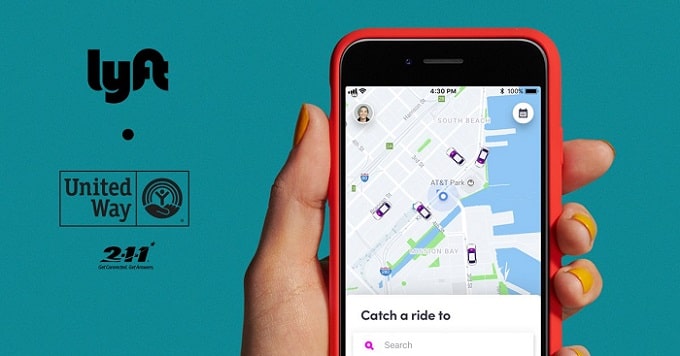With more and more people giving preference to ride-sharing services like Lyft instead of bearing significant overhead expenses of car ownership, the ride-sharing industry is growing at an impressive rate.
According to Statista, the global ride-sharing market is projected to grow by over 115% between 2021 and 2026. It is anticipated to reach a whopping $185 million in 2026.
So, no wonder why entrepreneurs look forward to investing in Lyft-like ride-sharing app development and show interest in how Lyft works.
Taking the same thought forward, we’ll throw light on the Lyft business model – how it works and makes money through this comprehensive post. So, keep reading!
Before you dig into the business and revenue model of Lyft, let’s first have a peek at what Lyft is all about and key details about it.
What is Lyft?

Founded in 2012 by Logan Green and John Zimmer, Lyft is a US-based on-demand transportation service platform. It has evolved into a multimodal platform that offers ride-hailing services with a wide range of vehicle options.
Besides that, it also offers car rental and food delivery services.
Lyft has a business equivalent to Uber and thus, it is often compared with Uber. Lyft is the second-largest ride-sharing service provider in the USA with a 32% market share after Uber holds 71% market share in the USA.
Currently, it has a presence across 644 regions in the USA and 12 regions in Canada.
Key Stats & Facts About Lyft
- Year of Foundation: 2012
- Founders: Logan Green and John Zimmer
- Headquarters: San Francisco, California, United States
- Industry: Transportation (Ride sharing)
- Number of Funding Rounds: 27 (As Per Lyft’s Crunchbase Profile)
- Total Funding Amount: $4.9B
- No. of Lead Investors: 13
- Number of Acquisitions: 11
Lyft’s Customer Segments
Lyft has two key customer segments: riders and drivers.
Riders:
- People without a car
- Those who don’t want to drive
- People who love to make new friends while traveling
- People seeking an affordable ride service from their doorstep
Drivers:
- People who have a vehicle and want to make money
- People who love to drive
- Those looking for a part-time or full-time job with a flexible schedule
Value Propositions Offered by Lyft
At present, Lyft has 2 million drivers and as of Q4 of 2021, 18.73 million people used Lyft for a ride. Its escalating growth can be attributed to unique value propositions offered to both riders and drivers.
Have a look below:
For Riders:
- Minimum waiting time
- A feeling of safety and comfort
- A wide range of options for a ride
- Economical rides
For Drivers:
- A source of income
- Flexible working schedule for convenience
- Quick payout system
- Extensive support via different programs
Business Model Explained: How Lyft Works?
Lyft operates on a peer-to-peer (P2P) business model that offers a platform to connect riders with drivers. But how does the Lyft app work for riders and drivers? Let’s explore in detail:
How Lyft Works for Riders?
Lyft enables its user to get a ride at the doorstep in minutes with a few quick taps. Have a look below:
Ride Request
To get started, riders need to first download the Lyft app which is available on both Google Play Store and Apple App Store.
Then, the rider can request a ride and the app will provide different ride options to choose from: Rentals, Bikes & Scooters, Wait & Save, Lyft, Priority Pickup, Preferred Mode, Lyft XL, Lyft Lux and Transit.
Matching
Upon receiving the request, Lyft sends a notification to the nearest driver. Once the ride is confirmed, the rider gets to see the driver’s details.
Ride
The app provides a map-based interface that empowers the rider to track the booked vehicle and its estimated time of arrival. The app also ensures live tracking throughout the trip.
Payment & Rating
Lyft has various payment modes for riders to pay for a ride including PayPal, Apple Pay, Venmo, Google Pay, credit cards, debit cards and prepaid cards.
The rider, though optional, can also tip the driver at the end of the ride. Also, the rider can rate the driver on a scale of 1 – 5 stars with comments. Likewise, the app enables drivers to rate their riders.
How Lyft Works for Drivers?
Like for riders, Lyft has a dedicated app for drivers.
Lyft has an Express Drive program for drivers who don’t own a car. Through this program, drivers can rent a car to start driving with Lyft.
But drivers have to go through a profile screening process before driving with Lyft. If the driver passes the profile screening process, they can then get started with the following steps:
Enable the Driver Mode
Once downloading the Lyft Driver app and setting up the profile, the driver can turn on the driver mode to start receiving a request.
Accept a Request
The driver can see the rider’s pickup location and on the basis of that, they can accept or decline a ride request.
Complete the Ride & Get Paid
As soon as the driver completes the ride, the app automatically processes the payment.
Lyft enables drivers to get paid within an hour or two via the Express Pay program. In addition to that, Lyft suggests drivers register for a Lyft Direct debit card to get instant access to their earnings.
Rating
Just like the rider can rate the driver, Lyft enables drivers to rate their riders.
Revenue Model Explained: How Lyft Makes Money?
In 2020, Lyft yielded a revenue of $2.3 billion. So, how does it generate revenue?
Below are its main revenue models explained in detail:
Commission-based Revenue Model
Lyft brings money to the table each time a driver completes a ride via its platform. For every ride, the company typically keeps 20% of the ride subtotal and the rest goes to the driver.
Note*: It may vary – there are some sources that highlighted that Lyft cuts more than 20% of the price.
Surge Pricing Revenue Model
Another source of revenue is surge prices in case of high demand.
Like Uber, Lyft has heat maps that are time and location-specific depict a region where the demand is high. When there is high demand in a specific region, Lyft increases prices on a temporary basis to strike the balance between demand and supply.
This surge in pricing contributes to the revenue model of Lyft.
Subscription-based Revenue Model
Lyft has a subscription program called Lyft Pink for riders.
At $19.99 per month or $199 per year, this program unlocks invaluable perks for riders including 15% off rideshare, free or discounted scooter rides, free ride relaxations and others.
Multimodal Business Model
As mentioned earlier also, Lyft has evolved into a multimodal on-demand transportation platform leveraging four essential transportation modes: Bikes & Scooters for shorter rides, Public Transit, Ridesharing Marketplace and Autonomous Vehicles (self-driving).
These efforts also add to the revenue model of Lyft.
Interested in Building a Ridesharing App Like Lyft?
Building an app like Lyft isn’t an easy ride if you don’t have a strong development partner at your side to bring your vision to reality.
Knowing today companies irrespective of size are struggling to hire and retain tech talent, we at InfoStride strive to help companies address this problem by providing instant access to pre-vetted and trained developers for hire on an hourly, monthly or project basis.
With InfoStride, you can hire dedicated developers or assemble a full-scale development team to build your Lyft-like app.
Some of the benefits we assure you:
- Save on recruitment costs: Our development consists of only pre-screened developers so that you can spare yourself from investing your valuable resources in sourcing and vetting potential candidates for your project.
- Administrative support: We assure you no hassle by taking care of every post-hiring aspect as well as from onboarding and infrastructure set up to payroll, taxes and compliance for your hired resources.
- Time-zone aligned developers: As we operate around the clock, we can deploy developers who are ready to work in your time zone for seamless remote collaboration.
Interested? All we need is some of your few details to get started. So, fill out the form below and one of our experts will get back to you.
Conclusion
With that, you now have got answers to how Lyft works and makes money.
It relies on the multimodal business model, subscription revenue model, commission revenue model and surge pricing model to generate revenue.
If you’re interested in building a Lyft-like transportation app that offers a wide range of services from ride-sharing to car rental, you must partner with skilled experts who have a strategic mindset to materialize your vision.
Explore more Business models of other Startups
THE AUTHOR
harish6854





